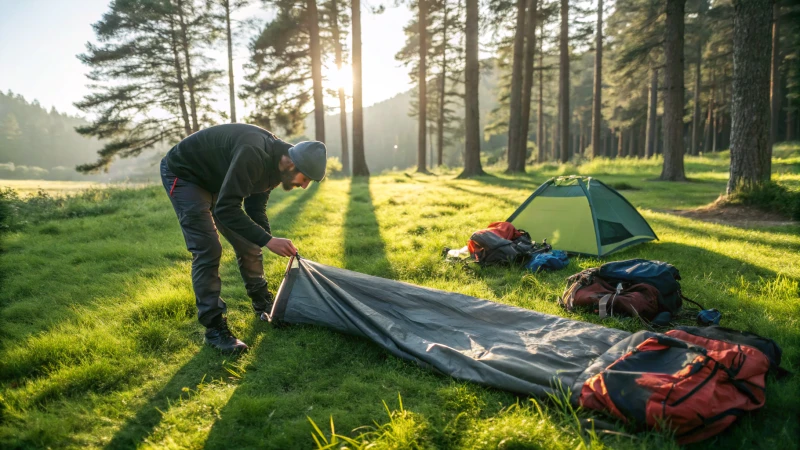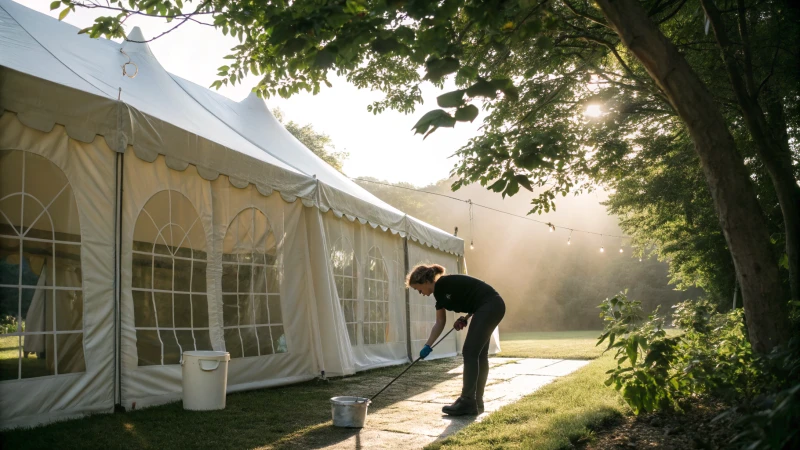
Cleaning a marquee tent might seem daunting, but it’s a satisfying ritual that keeps your event gear in top shape.
To clean a marquee tent effectively, start by brushing off debris, then gently scrub with a mild soap solution, avoiding harsh chemicals and high-pressure water. Ensure the tent is fully dry before storing to prevent mold and mildew.
I’ll admit, the first time I tackled cleaning my marquee tent, it felt like an epic chore. But with practice, I’ve learned it’s all about the right approach. Begin by gently removing any loose dirt and debris—think of it as giving your tent a good shake to wake it up. Next, mix some mild soap with warm water—nothing too fancy or harsh—and gently scrub the fabric. Trust me, blasting it with a high-pressure hose is tempting but not worth the potential damage. Instead, imagine you’re giving your tent a gentle spa day! After a thorough rinse, it’s crucial to let it dry completely; otherwise, you’re risking mold or mildew, and nobody wants that kind of surprise at the next event. With these steps, my marquee tent always looks fresh and ready for action.
High-pressure water is ideal for cleaning marquee tents.False
High-pressure water can damage the tent fabric, use mild soap instead.
Marquee tents must be dry before storage to prevent mold.True
Drying prevents mold and mildew, ensuring the tent's longevity.
How Do You Safely Remove Debris from Your Marquee Tent?
Ever struggled to keep your marquee tent looking pristine after a big event? Let me share how I tackle debris removal to ensure my tent stays spotless and ready for the next occasion.
To safely remove debris from your marquee tent, start by using a soft brush or broom to gently sweep away loose particles. Then, use a vacuum to capture finer dirt, especially along seams and edges, to avoid any potential damage.
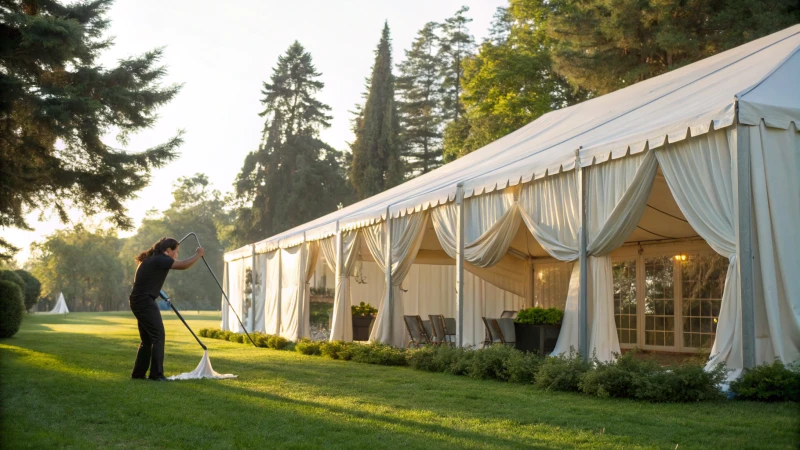
Preparing Your Tent for Debris Removal
Before diving into the cleaning process, it’s essential to make sure the tent is completely dry and securely anchored in an open space. I learned this the hard way after rushing through post-event cleanup only to find mold creeping in because I didn’t allow enough drying time. So, trust me, patience here pays off in preventing future headaches.
Essential Tools and Techniques
Brushing Off Loose Debris
I always start with a soft brush or broom to sweep away the larger chunks of dirt and leaves. This gentle approach avoids any accidental fabric damage. For those bigger tents or stubborn areas, I’ve found a leaf blower1 to be incredibly efficient in whisking away debris without fuss.
| Tool | Purpose |
|---|---|
| Soft Brush | Removes large debris like leaves and dust. |
| Leaf Blower | Efficient for large areas with loose debris |
Vacuuming Smaller Particles
When it comes to those pesky fine particles, a vacuum with a hose attachment works wonders. Focus on seams and edges where dirt loves to hide. It’s like giving your tent a gentle massage, preserving its waterproof features and overall longevity.
| Tool | Purpose |
|---|---|
| Vacuum Hose | Clears small particles without fabric harm. |
Addressing Stubborn Dirt Spots
If you find stubborn stains or dirt spots, don’t panic. I mix up a mild cleaning solution—usually some dish soap or specialized tent cleaner with warm water. A quick test on a hidden fabric section ensures no unexpected discoloration.
Gentle Scrubbing
With a soft cloth or sponge, I gently scrub at visible stains. Avoid those high-pressure water jets—trust me, they can wreak havoc on your tent’s delicate fabric or seams. For particularly tough spots, I’ve had success using natural cleaners like vinegar2 or baking soda.
Final Rinse and Dry
After scrubbing, rinse the tent thoroughly to wash away soap residues. I always ensure it dries completely in a well-ventilated area, ideally under indirect sunlight to prevent UV damage.
For more detailed care tips, this guide on fabric maintenance3 has been invaluable in extending my marquee tent’s life.
By following these strategies, I’ve managed to keep my marquee tent clean and ready for each new event without compromising its durability or functionality.
A soft brush is ideal for removing large debris from tents.True
Soft brushes gently remove large debris without damaging tent fabric.
High-pressure water jets are recommended for tent cleaning.False
High-pressure water can damage tent fabric and seams, use gentle methods.
What are the best cleaning solutions for tent fabric?
Ever wondered how to keep your tent fabric clean and lasting longer?
The best cleaning solutions for tent fabric include mild dish soap, tent-specific cleaners, and natural agents like vinegar or baking soda. Avoid harsh chemicals to prevent damage, and always test on a small area first.
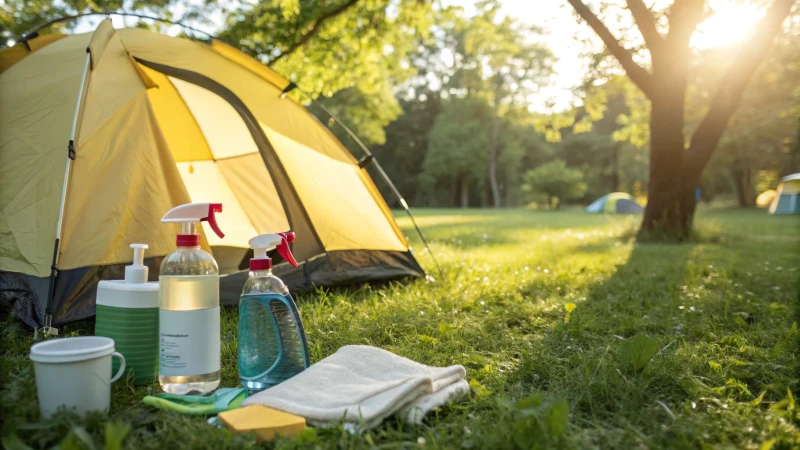
Mild Soap Solutions
Using a mild dish soap mixed with warm water is one of the safest options for cleaning tent fabric. I remember the first time I tackled a weekend’s worth of mud on my tent after a rainy camping trip. Mixing a tablespoon of mild soap in a gallon of water, I was amazed at how it effortlessly lifted the dirt without harming the material. Apply it gently with a soft cloth, ensuring you cover all areas, especially seams where dirt accumulates. This method4 is ideal for routine maintenance, keeping your tent looking new.
Tent-Specific Cleaners
Several brands offer tent-specific cleaning solutions designed to be gentle on fabric while tough on stains. These products are formulated to preserve the tent’s water-resistant coatings and UV protection. Brands like Nikwax and Gear Aid are popular choices. I once tried a tent-specific cleaner after an outdoor music festival, and it worked wonders on some stubborn grass stains without fading the vibrant colors of my tent.
Before using any cleaner, review the manufacturer’s guidelines to ensure compatibility with your tent material. This will help preserve the tent5 over time.
Natural Alternatives
For those who prefer eco-friendly options, vinegar and baking soda can be effective cleaners. A mixture of vinegar and water can tackle mold and mildew, while baking soda works well on stubborn stains. I once had an unfortunate spill of some mystery sauce during a camping barbecue, and baking soda was my savior. Sprinkle it directly on the stain, let it sit, then scrub gently with a damp cloth.
Always perform a spot test on a hidden section of fabric before applying these natural solutions6 more broadly.
Table: Comparison of Cleaning Solutions
| Solution | Effectiveness | Eco-Friendly |
|---|---|---|
| Mild Dish Soap | Moderate | Yes |
| Tent-Specific Cleaners | High | Varies |
| Vinegar and Baking Soda | Moderate | Yes |
Remember to rinse thoroughly after cleaning to remove any residue that could attract dirt or interfere with fabric performance. Proper care7 extends the life of your tent significantly.
Mild soap is safe for tent fabric cleaning.True
Mild dish soap mixed with water effectively cleans without damaging tent fabric.
Vinegar damages tent fabric coatings.False
Vinegar is a natural cleaner that can tackle mold without harming fabric coatings.
How Should You Clean and Inspect Tent Frames and Poles?
Ever thought about how the humble tent frame quietly supports your adventures? Let’s keep it in top shape with some simple care and attention!
To clean and inspect tent frames and poles, use a soft cloth with mild soap, checking for any rust or damage. Ensure they’re thoroughly dried to prevent corrosion. Regular checks are key to keeping your tent safe and sturdy.
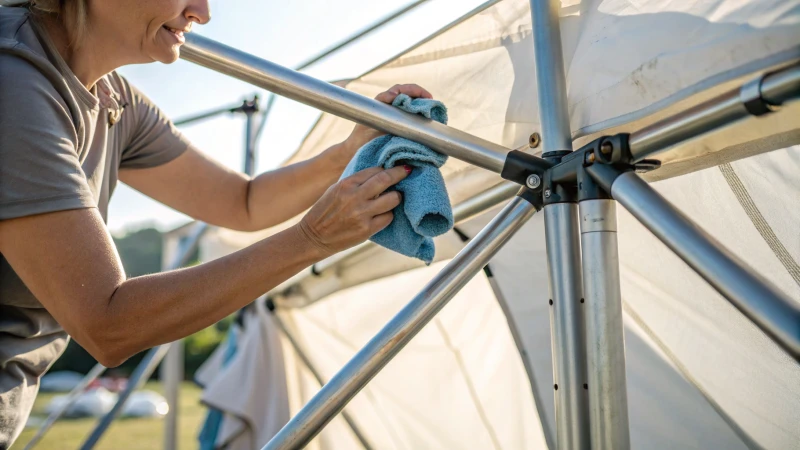
Cleaning the Tent Frames and Poles
When I first started camping, I remember how clueless I felt about maintaining my gear. It wasn’t until I faced a rusted pole mid-adventure that I realized the importance of regular cleaning. Now, every time I return from a trip, I mix a solution of mild soap and warm water.
| Cleaning Supplies Needed | Purpose |
|---|---|
| Soft Cloth | Wiping dirt and grime |
| Mild Soap | Cleaning solution |
| Vinegar | For stubborn spots |
Using a soft cloth, I gently wipe down each section of the poles, being careful to avoid anything abrasive. Once, when a stubborn stain refused to budge, a friend suggested diluted vinegar—always testing it on a small spot first, of course!
Inspecting for Damage and Corrosion
Post-cleaning, inspection has become my ritual. I learned the hard way that skipping this step can lead to unpleasant surprises on the trail.
Steps for Effective Inspection:
- Visual Check:
- Look for signs of rust, focusing on the joints where water tends to linger.
- Any dents or bends get my immediate attention.
- Hands-On Examination:
- Flexing the poles gently tells me if there are any hidden weaknesses.
- A crackling sound is never a good sign!
| Inspection Tool | Use |
|---|---|
| Wire Brush | Removing surface rust |
| Light Lubricant | Protecting joints |
Whenever I find rust, out comes the wire brush to save the day. And a bit of light lubricant helps keep those joints moving smoothly.
Drying and Storing Tent Frames and Poles
My drying routine might seem excessive to some, but laying everything flat in a breezy spot has saved my gear from many a mildew disaster.
- Air Dry: Lay the pieces flat in a well-ventilated area.
- Avoid Direct Sunlight: Lessons learned—sun can warp materials faster than you’d think.
Storing them in a protective bag8 is my final step before dreaming up the next adventure.
Vinegar can be used to clean stubborn spots on tent poles.True
Vinegar is effective for stubborn spots but should be tested first.
Direct sunlight is recommended for drying tent frames.False
Direct sunlight can cause warping; air dry in shade instead.
Why Is Proper Tent Storage Essential After Cleaning?
Ever wondered why storing your tent properly after cleaning makes such a difference? Let me share why it’s more than just tidying up.
Proper tent storage after cleaning is crucial to prevent mold, mildew, and fabric deterioration. By ensuring the tent is completely dry and stored in a clean, dry environment, you significantly enhance its longevity and functionality.
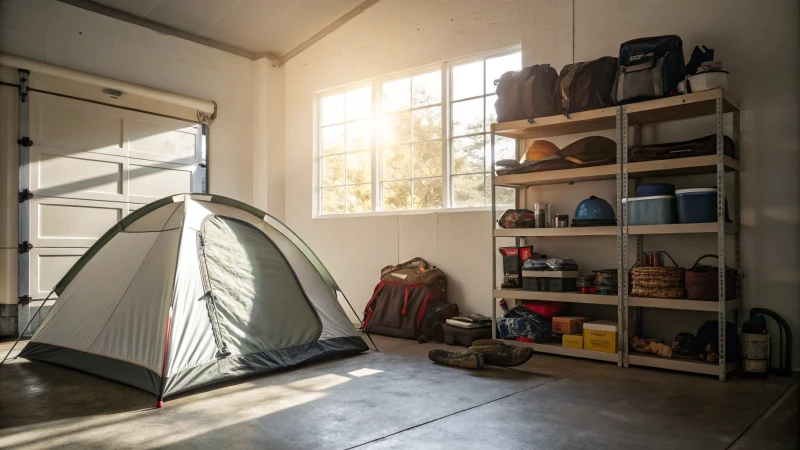
Protecting Against Mold and Mildew
I remember the first time I left my tent slightly damp after a weekend getaway. The smell of mildew hit me hard when I opened it up next time. So now, I always make sure it’s bone dry before storing.
-
Dry Before Storing: Always allow your tent to air out completely after cleaning. Hanging it in a well-ventilated area helps prevent moisture buildup.
-
Choose the Right Location: Store your tent in a dry, cool place. Avoid attics or basements prone to humidity.
Preventing Fabric Deterioration
I’ve learned the hard way that exposure to sunlight can really take a toll on tent fabric. Those vibrant colors fade fast! The fabric care9 is crucial to maintain its durability.
-
Avoid Direct Sunlight: Prolonged exposure can degrade fabric, leading to tears or color fading.
-
Use Protective Bags: Keep the tent in a breathable storage bag to shield it from dust and pests, which is something I’ve found invaluable.
Maintaining Structural Integrity
Once, I haphazardly packed my tent poles, and they ended up bent. Now, I’m meticulous about how I fold and store them.
| Step | Action |
|---|---|
| Fold tent along seams | Ensures even weight distribution |
| Bundle poles separately | Prevents bending or warping |
-
Careful Folding: Following the original creases keeps stress off the fabric.
-
Pole Storage: Store poles in their dedicated bag to prevent loss or damage.
Ensuring Longevity and Reusability
I’ve found that a little care goes a long way. Regular checks have saved my tent from unnoticed pest invasions or moisture issues. Tent longevity10 is directly linked to how well it’s stored post-cleaning.
-
Regular Checks: Periodically check your stored tent for signs of pests or moisture now and then can prevent nasty surprises.
-
Scheduled Maintenance: Implement regular maintenance checks for any structural damages or repairs needed before heading out again. It’s a small step for peace of mind.
Tents should be stored in humid environments.False
Humid environments promote mold growth, damaging the tent.
Properly folded tents last longer.True
Correct folding prevents stress points, maintaining fabric strength.
Conclusion
Learn effective methods to clean and maintain your marquee tent, ensuring its longevity and appearance by removing debris, using mild cleaning solutions, and proper storage techniques.
-
Explore efficient leaf blower options ideal for removing debris from large tents quickly and safely. ↩
-
Learn how vinegar can serve as a safe and effective cleaning agent for tents. ↩
-
Discover detailed tips on maintaining tent fabrics to enhance their longevity and appearance. ↩
-
Learn the ideal process for using mild soap solutions to clean your tent fabric safely. ↩
-
Discover products designed to clean tent fabric without compromising its protective coatings. ↩
-
Explore eco-friendly cleaning methods using common household items like vinegar and baking soda. ↩
-
Find out how proper cleaning and maintenance can extend your tent’s lifespan. ↩
-
Discover options for protective storage bags that help maintain your tent’s condition during off-seasons. ↩
-
Learn methods for preserving tent fabric after cleaning to prevent damage and ensure durability. ↩
-
Discover strategies for extending the lifespan of your tent through proper care and storage. ↩



